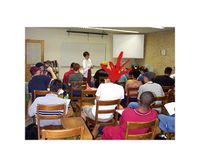Number sense
Number sense is a contest sponsored by University Interscholastic League representatives somewhere down in Texas. It is a mathematical contest in which all participants must use their brain to solve 80 questions mentally in 10 minutes. It often causes SEHS and in some cases, death.
There are two variations of the contest. The first, and most common, allows participants to write down answers without using any scratch work or calculators of any kind. The second, however, does not allow to participant to use a pencil, instead further enhancing mental abilities by forcing participants to telepathically transmit their answers to their paper.
Competition Details[edit | edit source]
Students are trapped in a room, most commonly a high school room (though sometimes college), with a proctor. The tests are handed out to the students, face down. Any student that looks at the test before hand will be disqualified (or in rare occasions, murdered). When the proctor says "Go" or "Start the fucking test," the students are allowed to look at the tests and begin working all the problems. They are to be timed for 10 minutes and no scratch work, marking over wrong answers, or erasing wrong answers is not allowed. For every problem answered correctly, you are awarded five points; for every problem skipped or answered incorrectly, four points are deducted from your score. It is impossible to score a perfect score unless you are God. In fact, anything over 300 at least warrants Deity status.
Equations[edit | edit source]
The difficulty of the problems vary from test to test, ranging from stupid easy to impossible. Examples are:
Example 1): _______.
Example 2): _______.
Example 3): The is defined as where C is some arbitrary constant. If the , then the (rounded to 4 decimal places) is _______.
As you can see, for the most part the problems are quite difficult (especially the first two examples). However, there are short cuts typically found for each problems.
Example 1[edit | edit source]
By using the Identity Property of Addition we are able to separate the problem:
From here, we can take advantage of the Distribution Property and manipulate it further to get:
We can then simplify the inside of the brackets:
We can then recognize that and substitute:
Spreading out all the factors and taking away the brackets leaves us:
You can then derive the answer using simple multiplication and fill it in the answer blank, which looks like this:
Example 2[edit | edit source]
This is commonly referred to as the Three's Trick. To first tackle this problem, one must first realize that . We can then substitute it into the equation, like so:
You then can notice the s cancel out, leaving you with:
Example 3[edit | edit source]
Example 3 is usually considered one of the easier problems on the test (and they show up frequently). Simple counting is all that is required to derive that:
Practice[edit | edit source]
Though in most cases you will be unable to score higher than a 8, if you are determined enough you can achieve double digits. The most effective study habit is to take 5 number sense practice tests every 7 minutes. The goal is to concentrate so hard you actually create a time warp causing yourself to relive the same 7 minutes numerous times, like an equally-bad version of the movie Groundhog Day. Even though there have been other study patterns developed over the years, they've all been discovered to be completely worthless.





















